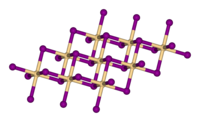- Magnesium bromide
-
Magnesium bromide[1] 
Identifiers CAS number 7789-48-2  , (anhydrous)
, (anhydrous)
[13446-53-2] (hexahydrate)
[75198-45-7] (decahydrate)PubChem 522691 ChemSpider 74219 
UNII 2VC6P60SLN 
Jmol-3D images Image 1 - [Mg+2].[Br-].[Br-]
Properties Molecular formula MgBr2 (anhydrous)
MgBr2·6H2O (hexahydrate)Molar mass 184.113 g/mol (anhydrous)
292.204 g/mol (hexahydrate)Appearance white hygroscopic hexagonal crystals (anhydrous) colorless monoclinic crystals (hexahydrate) Density 3.72 g/cm3 (anhydrous)
2.07 g/cm3 (hexahydrate)Melting point 711°C (anhydrous)
172.4°C, decomposes (hexahydrate)Solubility in water 102 g/100 mL (anhydrous)
316 g/100 mL (0 °C, hexahydrate)Solubility ethanol: 6.9 g/100 mL (20 °C) Structure Crystal structure Rhombohedral, hP3, SpaceGroup = P-3m1, No. 164 Coordination
geometryoctahedral Thermochemistry Std enthalpy of
formation ΔfHo298-524.3 kJ·mol-1 Standard molar
entropy So298117.2 J·mol-1·K-1 Hazards EU Index Not listed Related compounds Other anions magnesium fluoride
magnesium chloride
magnesium iodideOther cations Beryllium bromide
Calcium bromide
Strontium bromide
Barium bromide
Radium bromide (verify) (what is:
(verify) (what is:  /
/ ?)
?)
Except where noted otherwise, data are given for materials in their standard state (at 25 °C, 100 kPa)Infobox references Magnesium bromide (MgBr2) is a chemical compound of magnesium and bromine that is white and deliquescent. It is often used as a mild sedative and as an anticonvulsant for treatment of nervous disorders.[2] It is water soluble and somewhat soluble in alcohol. It can be found naturally in small amounts in some minerals such as: bischofite and carnallite, and in sea water, such as that of the Dead Sea.[3][4]
Synthesis
Magnesium bromide can be synthesized by reacting hydrobromic acid with magnesium oxide and crystallizing the product.[4] It can also be made by reacting magnesium carbonate and hydrobromic acid, and collecting the solid left after evaporation.[3]
An alternative route is adding magnesium to a solution of liquid ammonia and sodium bromide, then evaporating the solvent off and collecting the precipitate.[5]
Uses
Magnesium bromide is used at a catalyst for many reactions, typically as a solvent or used as a Grignard reagent. The first being a solvent free one pot synthesis of dihydropyrimidinones which are used most often in the pharmaceutical world. Dihydropyrimidinones are used in medications such as calcium channel blockers, and HIVgp-120-CD4 inhibitors.[6] It also has been used as a tranquilizer.[3] Magnesium bromide in combination with CH2Cl2 catalyzes a reaction that causes specific symmetry and chiral centers through hydrogenation of olefins.[7] Magnesium bromide when bonded to other functional groups has shown more practical uses other than catalyzing reactions. When bonded to an ethyl group it is used for regiospecific analysis of triglycerols.[8] Magnesium bromide hexahydrate is being worked with to be used as a flame retardant. It was found that if 0.125 mol/L of magnesium bromide hexahydrate was added to a cotton material it acted as a flame retardant.[9] Magnesium bromide was used to synthesize the first stable magnesium silylenoid. A silylenoid is a compound that contains R2SiMX (M is metal and R is an organic moiety). Traditionally only lithium, potassium, and sodium could be used. The magnesium silylenoid is synthesized through the addition of magnesium bromide to lithium lithium methyl bromosilylenoid. The magnesium atom replaces the lithium in the complex and has a bromide attached to it. This complex is stable at room temperature.[10]
References
- ^ Lide, David R. (1998). Handbook of Chemistry and Physics (87 ed.). Boca Raton, FL: CRC Press. pp. 4–67. ISBN 0849305942.
- ^ Pradyot Patnaik. Handbook of Inorganic Chemicals. McGraw-Hill, 2002, ISBN 0070494398
- ^ a b c Gruyter, W. Conise Encyclopedia Chemistry, Walter de Gruyter & Company: Berlin, 1993; 612
- ^ a b Lewis, R.J. Hawley’s Condensed Chemical Dictionary, 15th ed.; John Wiley &Sons Inc.:New York, 2007; 777
- ^ Jacobson, C.A. Encyclopedia of Chemical Reactions, Reinhold Publishing Corporation: New York, 1951; 409
- ^ Salehi, Hojatollah; Guo, Qing‐Xiang (2004). "A Facile and Efficient One‐Pot Synthesis of Dihydropyrimidinones Catalyzed by Magnesium Bromide Under Solvent‐Free Conditions". Synthetic Communications 34 (1): 171. doi:10.1081/SCC-120027250.
- ^ Bouzide, Abderrahim (2002). "Magnesium Bromide Mediated Highly Diastereoselective Heterogeneous Hydrogenation of Olefins". Organic Letters 4 (8): 1347. doi:10.1021/ol020032m. PMID 11950359.
- ^ Ando, Y; Tomita, Y; Haba, Y. Preparation of Ethyl Magnesium Bromide for Regiospecific Analysis of Triacylglycerols Journal of Oleo Science, 2008, 57, 459
- ^ Mostashari, S. M.; Fayyaz, F. (2008). "XRD characterization of the ashes from a burned cellulosic fabric impregnated with magnesium bromide hexahydrate as flame-retardant". Journal of Thermal Analysis and Calorimetry 92 (3): 845. doi:10.1007/s10973-007-8928-4.
- ^ Lim, Young Mook; Cho, Hyeon Mo; Lee, Myong Euy; Baeck, Kyoung Koo (2006). "A Stable Magnesium Bromosilylenoid: Transmetalation of a Lithium Bromosilylenoid by Magnesium Bromide". Organometallics 25 (21): 4960. doi:10.1021/om060589w.
Magnesium compounds Categories:- Bromides
- Magnesium compounds
- Metal halides
Wikimedia Foundation. 2010.
